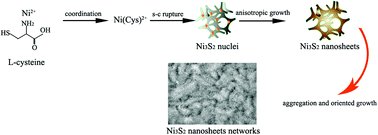Biomolecule-assisted synthesis of porous network-like Ni3S2 nanoarchitectures assembled with ultrathin nanosheets as integrated negative electrodes for high-performance lithium storage†
Abstract
Porous network-like Ni3S2 nanoarchitectures have been successfully synthesized on nickel foam via a facile eco-friendly biomolecule-assisted hydrothermal process, in which L-cysteine serves as both a sulfur source and a directing molecule in the formation of Ni3S2 nanoarchitectures. The possible formation mechanism of network-like Ni3S2 nanostructures has been proposed on the basis of the experimental results. The unique three-dimensional network-like Ni3S2@NF nanoarchitectures can produce a synergistic effect for facilitating electron transport and ionic diffusion within the electrode, accommodating the volume expansion during cycling and leading to excellent electrochemical performance. The resulting binder-free Ni3S2@NF electrode delivers a high reversible specific capacity of 847.82 mA h g−1 at a current density of 200 mA g−1, which remains at 569.86 mA h g−1 even after 300 cycles (a 67.21% retention of the second cycle), and excellent rate performance. This facile, environmentally benign and solution-phase biomolecule-assisted method can be potentially extended to the preparation of other novel porous chalcogenides with potential applications in the fields of hydrogen storage, high-energy batteries, supercapacitors, and catalysis.



 Please wait while we load your content...
Please wait while we load your content...